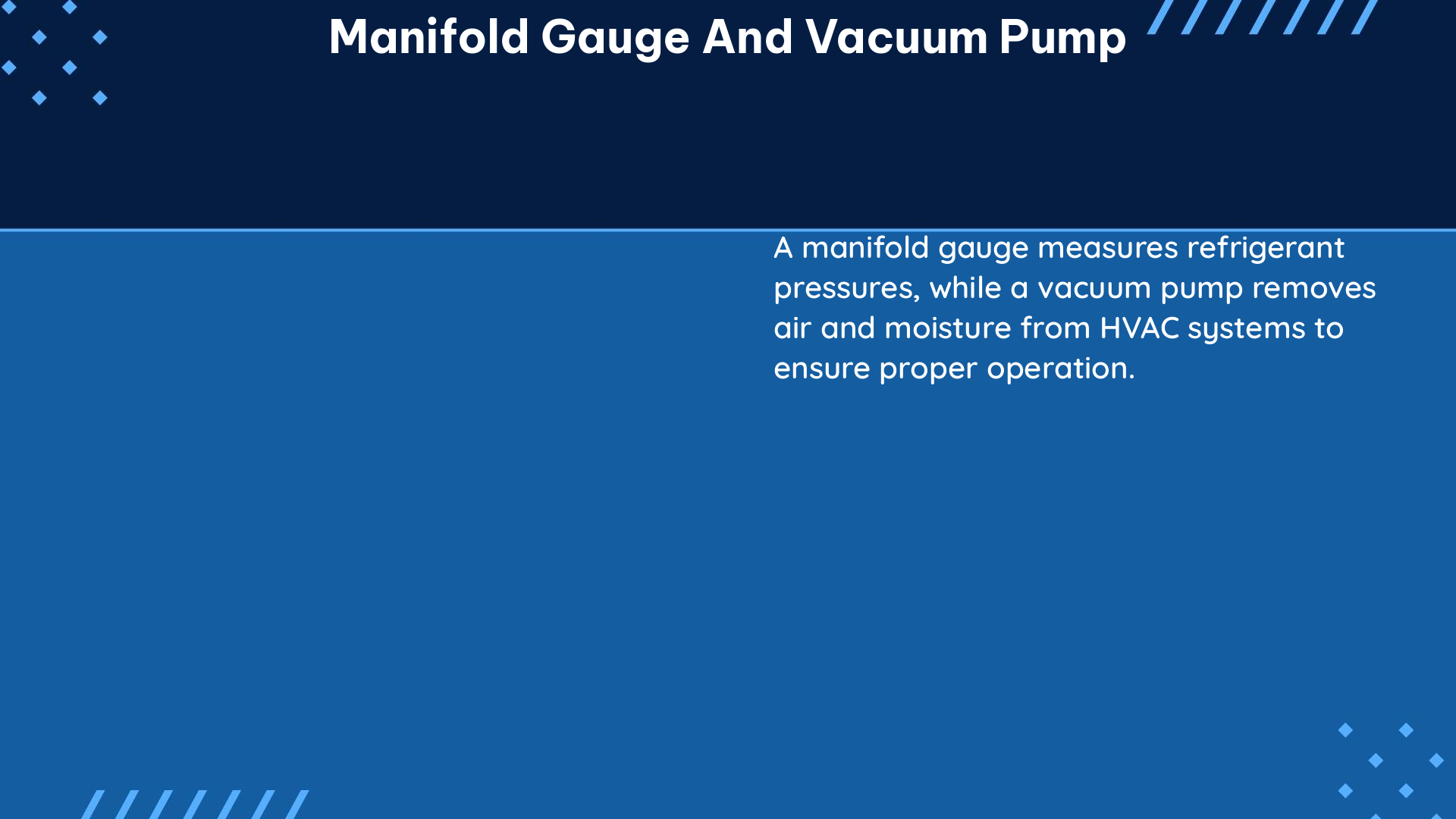Manifold gauges and vacuum pumps are essential tools in the HVAC/R industry, enabling technicians to accurately measure and control the pressure and vacuum levels in refrigeration systems. These instruments play a crucial role in the maintenance, repair, and installation of air conditioning, refrigeration, and heat pump systems. In this comprehensive guide, we will delve into the technical specifications, features, and practical applications of manifold gauges and vacuum pumps, empowering you to become a proficient DIY enthusiast in the world of HVAC/R.
Manifold Gauge: Precision Pressure Measurement
Manifold gauges are designed to measure the pressure of refrigerants in HVAC/R systems. These instruments provide a wealth of information, allowing technicians to diagnose and troubleshoot issues with remarkable accuracy.
Pressure Measuring Range
The pressure measuring range of a manifold gauge is a crucial specification that determines the system pressures it can accommodate. For instance, the Elitech DMG-1 Digital AC Manifold Gauge Set has a pressure measuring range of -0.100 to 5.000 MPa, enabling it to handle a wide variety of refrigeration systems.
Operating Temperature and Humidity
Manifold gauges must be able to withstand the environmental conditions encountered in HVAC/R applications. The Elitech DMG-1 has an operating temperature range of -10°C to 60°C and a humidity range of 35% to 85% RH, ensuring reliable performance in diverse climates.
Resolution and Accuracy
The resolution and accuracy of a manifold gauge are critical for precise measurements. The Elitech DMG-1 boasts a resolution of 0.001 MPa for pressure and ±1°C for temperature, with an accuracy of ±0.5% FS for pressure and ±1°C for temperature.
Battery Life
Manifold gauges are often battery-powered, and their battery life can vary. The Elitech DMG-1 has a remarkable battery life of six months, minimizing the need for frequent battery replacements.
Measurement Units
Manifold gauges can display pressure measurements in a variety of units, including MPa, kPa, bar, psi, kgf/cm², and mmHg. This versatility allows technicians to work with the units most familiar to them or required by the specific HVAC/R system.
Vacuum Pump: Efficient Air Evacuation

Vacuum pumps are essential tools for evacuating air and moisture from refrigeration systems, preparing them for the introduction of refrigerant.
Airflow Rate
The airflow rate of a vacuum pump determines the volume of air it can move in a given time. The Pro Series Manifold Gauge from NAVAC, for example, has an impressive airflow rate of 3.5 CFM (cubic feet per minute).
Maximum Vacuum Level
The maximum vacuum level that a pump can reach is a critical specification. The Pro Series Manifold Gauge from NAVAC can achieve a remarkable vacuum level of 29.9″Hg (inches of mercury), ensuring thorough air evacuation.
Power Consumption
Vacuum pumps require a specific power supply to operate. The Pro Series Manifold Gauge from NAVAC consumes 115V AC, 60Hz, and 1.2A, making it compatible with standard household electrical outlets.
Weight and Dimensions
The weight and dimensions of a vacuum pump can impact its portability and storage. The Pro Series Manifold Gauge from NAVAC weighs 10.5 lbs and has dimensions of 10.2″ x 6.7″ x 14.2″, making it a compact and easily transportable option.
Manifold Gauge and Vacuum Pump DIY: Step-by-Step Guide
When it comes to DIY HVAC/R maintenance and repair, understanding the proper use of manifold gauges and vacuum pumps is essential. Follow these steps to ensure a successful and safe experience:
-
Connect the Manifold Gauge: Securely attach the manifold gauge to the refrigeration system using the appropriate hoses and fittings. Ensure that the hoses are in good condition and properly connected to prevent leaks.
-
Set the Manifold Gauge: Adjust the manifold gauge to the correct pressure and temperature units. Verify that the gauge is properly calibrated and accurate.
-
Connect the Vacuum Pump: Connect the vacuum pump to the low-pressure side of the refrigeration system using the appropriate hoses and fittings.
-
Operate the Vacuum Pump: Turn on the vacuum pump and allow it to run until the desired vacuum level is reached. Continuously monitor the vacuum level using the gauge on the manifold.
-
Charge the Refrigeration System: Once the desired vacuum level is achieved, close the valves on the vacuum pump and manifold gauge. Proceed to charge the refrigeration system with the appropriate refrigerant using the high-pressure side of the manifold gauge.
Remember to always follow the manufacturer’s instructions and safety guidelines when working with manifold gauges and vacuum pumps. Proper use of these tools is essential for maintaining the efficiency and longevity of your HVAC/R systems.
References
- Elitech DMG-1 Digital AC Manifold Gauge Set with R410a Adapter: https://www.elitechus.com/products/elitech-dmg-1-double-digital-pressure-gauge
- Pro Series Manifold Gauge – NAVAC: https://navacglobal.com/product/pro-manifold-gauge/
- Digital Pressure Gauge, AC Manifold Gauge, Refrigerant – ElitechEU: https://www.elitecheu.com/collections/digital-pressure-gauge

The lambdageeks.com Core SME Team is a group of experienced subject matter experts from diverse scientific and technical fields including Physics, Chemistry, Technology,Electronics & Electrical Engineering, Automotive, Mechanical Engineering. Our team collaborates to create high-quality, well-researched articles on a wide range of science and technology topics for the lambdageeks.com website.
All Our Senior SME are having more than 7 Years of experience in the respective fields . They are either Working Industry Professionals or assocaited With different Universities. Refer Our Authors Page to get to know About our Core SMEs.